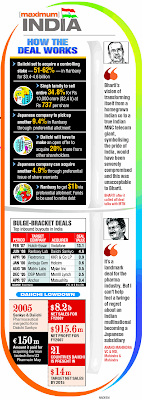
Coca-Cola India, ACC and Gujarat Ambuja, Gokaldas Exports, Anchor...
WHILE Indian firms have been striking bulge bracket deals overseas, multinational firms are slowly but surely picking some gems in the domestic market. Over the last few years, some of the sectoral leaders have been snapped up by MNCs who have taken a short cut to hit the bulls’ eye in one of the fastest growing emerging markets in the world. While Ranbaxy’s sell-off to Japanese drug maker Daiichi Sankyo is the latest to join the list, other companies in sectors like cement, electrical products and apparel have also witnessed sell-offs.
The first big sale happened way back in 1993 when Ramesh Chauhan sold off a slew of soft drink brands to Coca-Cola India. This was followed by a series of small-time sell-offs by Indian business groups to MNCs who were looking to set a foothold in India after the economy opened up.
While there were numerous sell-offs thereafter, market leaders were not part of them in most cases and MNCs continued to snap up top players in smaller niche areas. Over the last three years, a number of blue chips and other category leaders have been bought over by MNCs or private equity funds.
For instance, Swiss cement maker Holcim struck a double deal by acquiring the top two cement makers in the country— ACC and Gujarat Ambuja. Holcim started by acquiring the stake of founder Sekhsaria and Neotia families in Gujarat Ambuja and indirectly got a significant minority stake in ACC. It later upped its stake through a public offer. The sell-off was prompted by two basic issues: right valuation and issues related to family succession.
Today, Holcim controls India’s largest cement manufacturer ACC with close to a 43% stake in the company, besides holding 46% stake in Ambuja Cement (formerly Gujarat Ambuja).
It’s not just strategic acquirers who have managed to acquire sector leaders. Last August, private equity fund Blackstone acquired country’s largest apparel maker and exporter, Gokaldas Exports. The PE player bought the promoters’ 50.1% stake in Gokaldas for $165 million and bought another 20% through an open offer in what was considered to be a overvalued transaction.
“It was in the interest of the company to partner Blackstone, whose financial strength and stakes in different companies across the world would help Gokaldas expand and also ensure an assured large orderflow to the company,” says Gokaldas Exports MD Rajendra Hinduja, whose family still holds 20% in the company and manages the company on a daily basis.
“In textile, the return on the capital employed and management effort undertaken by the company is much less compared to other industries. So it made sense for the promoters to offload stake in Gokaldas and deploy the money in businesses where the returns are much higher,” says a industry source, on why promoters, who had run the company for over 25 years, decided to cede control to Blackstone.
In another buyout last year, Japanese firm Matsushita Electric Industrial bought 80% of privately held electric equipment maker Anchor Electricals. The Mumbai-based Shah family that retains 20% stake pocketed $480 million for giving up majority stake in the firm, which has close to a one-third share in the domestic electrical products market.





